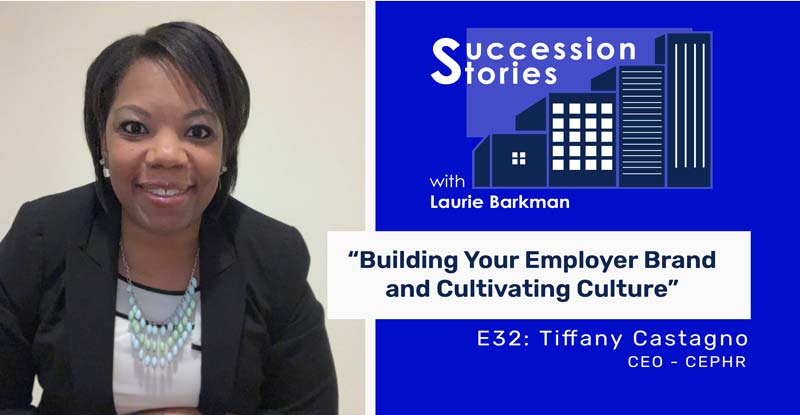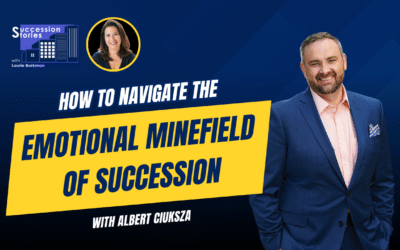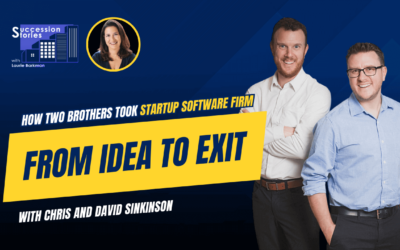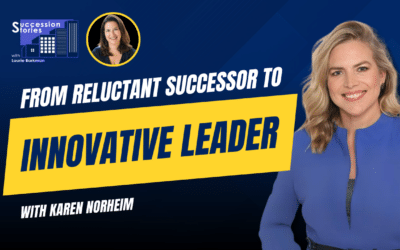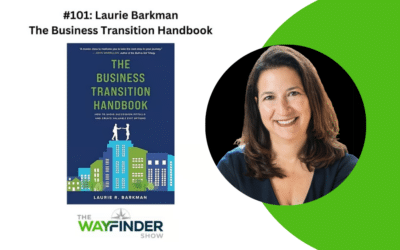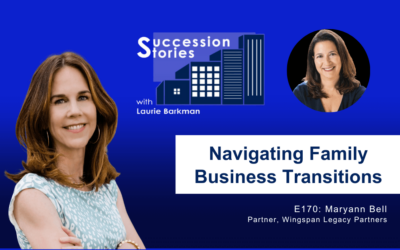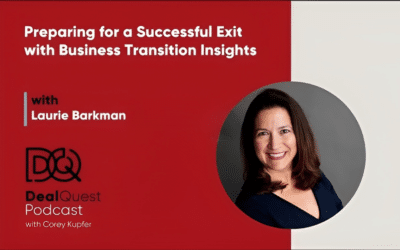Listen to the episode:
Laurie Barkman talks about building your employer brand and cultivating culture with Tiffany Castagno, CEO of CEPHR, a human resources consulting firm. Having a strong culture is foundational to succession and transition planning. As organizations adapt to changes from the pandemic, how do you maintain an environment that fosters productivity, authentic engagement, and safeguards employee wellbeing?
Listen in to learn more about:
- Critical components of brand and culture
- Conducting succession planning
- How transitions intersect with an organization’s culture
- Difference between high potentials and high performers
- Effective leadership amidst a crisis
- Adapting to changes in teamwork
Show Links
Connect with the host, Laurie Barkman, CEO of SmallDotBig, and sign-up for an insights newsletter to build value in your company.
Subscribe to the podcast
Subscribe wherever you listen, Apple Podcasts, Google Podcasts, Spotify, YouTube, and more.
If you enjoy the episode, please give a 5-star rating and review to help others find the content. Here’s a quick how-to review on Apple Podcasts/iTunes from your desktop.
Episode transcript:
Laurie Barkman:
Welcome to Succession Stories, insights for next generation entrepreneurs. I’m Laurie Barkman. I’ve spent my career bringing an entrepreneurial approach to mature companies struggling with change as an outside executive of a third generation, 120 year old company, I was part of a long-term succession plan.
Now I work with entrepreneurs, privately held companies, and family businesses to develop innovations that create enterprise value and transition plans to achieve their long-term goals. On this podcast, listen in as I talk with entrepreneurs who are driving innovation and culture change. I speak with owners who successfully transitioned their company and others who experienced disappointment along the way.
Guests also include experts in multi-generational businesses and entrepreneurship. If you are a next generation entrepreneur looking for inspiration to grow and thrive, or an owner who can’t figure out the best way to transition their closely held company, this podcast is for you.
Subscribe to our newsletter for more resources to build value in your business and plan your transition. Visit SmallDotBig.com and sign up today.
Laurie Barkman:
Thanks to all of the listeners who submitted questions on LinkedIn. Quite a few came in about the people side of business. In my hundreds of conversations I’ve had with CEOs over the years, one thing is clear: to build sustainable business value means you need a winning team. I hear you on that, and I’ll be doing more episodes on HR themes.
Today I was joined by Tiffany Castagno, CEO of CEPHR, to talk about building your employer brand and cultivating culture during the crisis and beyond. What are the behaviors that drive you as an organization? What do you want to be known for?
I love questions that lead to new insights, and suspect that you will find more than a few of them in my conversation with Tiffany.
Laurie Barkman:
Business is about people, and Tiffany that’s why I’m so excited you’re here with me today…because you are a connector and you’re somebody who is so in tune with people. You call yourself a “curator of culture.”
So many times on the show, that’s ultimately where our conversations go. Leaders talk about their teams, and company culture, and, as you know, it’s about people and relationships. I’m glad you’re here with me today, and I think whether you’re a small company or a big company, you’ll be able to relate to what Tiffany and I talked about. So Tiffany, welcome.
Tiffany Castagno:
Thank you, Laurie. I’m so grateful to be here. This is gonna be an exciting conversation. I just know it. I love your podcast, and I’m excited to be here. So I wanted to share a little bit about myself. I call myself an HR generalist, turned HR business partner, turned HR manager, director, and now CEO, entrepreneur.
I am CEO of CEPHR – that’s an acronym for “Cultivating the Evolution of Professional HR.” I work with small to midsize businesses helping them scale their business, build their employer brand and their culture. That’s really fun for me, I get to leverage my expertise while helping guide them along the way. I am based in Pittsburgh, but it’s a national practice, and I’m from Milwaukee, Wisconsin.
Laurie Barkman:
Wow, there’s a lot in there, so let’s go through a couple of things. You’re an HR expert, and you transitioned to starting your own firm, which is very cool. Congratulations on that. We do celebrate transitions on the show so congratulations to you. Let’s talk about leadership. Let’s talk about leadership during the crisis. What behaviors help leaders manage a crisis?
Tiffany Castagno:
I think for one, it’s understanding that you shouldn’t, if at all possible, be firefighting. I think in this pandemic, what we’ve seen is everyone had to react. We had no choice but to react and to do so quickly and make decisions quickly. I think being proactive about that, if you can. I hope what this has taught people is to be more proactive, versus what’s the day to day. To really look out long term, and to determine what the business needs.
I think for a long time employers and organizations have made more snap decisions or gut decisions. This feels good at the time. This is what we think we need. This what we think customers need. But that doesn’t always serve the business in the long term. So anytime you can connect things to strategy and create a roadmap, that’s going to be best. That means leadership leaning in; it means leaning on your team and a lot of collaboration. To me, that’s where I’ve seen the most success in organizations.
Laurie Barkman:
Have ways of collaborating changed during this time?
Tiffany Castagno:
Definitely. Now a lot of us are in this virtual environment. The way we connect, we can’t usually see people for lunch breaks anymore, we don’t have those random standbys by the desk, and I for one, miss those.
I think that it’s a different way that we have to work harder, probably things we should have been doing in the first place. We have to work harder at those relationships; at fostering them, building them, and tapping into what other people know.
Technology has been our friend in this age, and it helps connect us but also brings visibility into projects. I’ve seen some of my clients actually benefit from the virtual environment and feel more connected than they were when they were in the physical office.
Laurie Barkman:
So what about the flyby communications? What’s replaced, not the water cooler conversations, but the touch bases? Is it all over Zoom and Microsoft Teams and all virtual? Has that just sort of shifted gears? Is that what you’re saying?
Tiffany Castagno:
For the most part. Some people are comfortable doing small gatherings. There’s been some grumbles about holiday parties. How will we do that? How are people doing their conferences?
LinkedIn has been a great tool for me personally, in my business, and I know that a lot of people are connecting there, as well. Some people are doing smaller gatherings, outdoor gatherings. Even when you look at networking events, those look a little different, and people are starting to come a little bit out of their comfort zones and still try to be safe.
The important thing, I think, for leadership in particular is to reach out to their teams and make sure you’re checking in. I think I have personally seen a lot more of that in teams, and people checking in on each other to say, how are you doing? How are you feeling? How can I support you? That support looks different than it used to in a good way.
Laurie Barkman:
Support is a good topic. I noticed on your blog that you wrote quite a bit around mental health, and you have some content on your site about mental health. How are you advising organizations and leaders to be checking in and looking for red flags for their teams and their people? What are some of the signs that someone really might need help?
Tiffany Castagno:
I’m so glad you asked this because I think that we’re going to see even more of a shift with this moving forward. We have to be checking in on our teams, that’s something we should have always been doing. I have always talked to leaders, organizations, and to employees about knowing when somebody seems like maybe they’re just a little off.
These are emotionally charged, very difficult, very uncertain times. That, naturally, is going to lend itself to us being in more of a mental health crisis. So if your co-worker is usually very vibrant, and bubbly, and they’ve suddenly kind of shut down, check in on them, ask them how things are going because people also have their children at home, and they’re doing virtual school. I do not have children, but I am super empathetic to being in that position, because it’s not easy.
We are also having people be on Zoom or whatever platform we are on. People now have opened up the privacy of their homes while people are staring at them on a screen and that’s for some people, especially if you’re introverted can be a lot to take in. So I always recommend not checking in just to say, hey, how’s that project coming along, but how are you doing? What support do you need?
As leaders, we have to support our teams, and part of that, too, is saying, maybe this person is still kind of bubbly, but something’s just different, or they’re starting to miss more work, or there’s certain signals and things that they’re saying. For parents it’s really different. That can be they’re suddenly crying at work, or they’re very angry. There are some telltale signs that can put us on the path to making sure we give some additional check in.
Laurie Barkman:
I know larger organizations are doing surveys. Companies like Qualtrics, and others have COVID-19 focus surveys, which I think are helpful, but there’s no substitute for that authentic reach out to say to someone hey, how are you doing?
What have you seen in terms of values? How have company’s values helped them make decisions? Be they very challenging decisions or otherwise, during the pandemic?
Tiffany Castagno:
I think that the organizations that do well are the ones who are focused on the long term, who do have a mission, and stick to their strategy. I think a lot of our strategies have certainly changed over time as they should have. But as long as you’re connected to your mission, it’s going back to the foundation of what makes you– you. What is the fabric and fiber of your organization? What do you want to be known for?
That’s a lot of the work that I do on brand and culture. If you have that foundation, and you’re comfortable that you’ve led the organization in that way, it’s sticking to that, and the behaviors that drive you as an organization. What do you want to be known for? Those are the organizations that have done well during this pandemic, and they have been able to quickly shift. I always recommend a good strategy. We’re kind of lost without one, and it leads the path.
Laurie Barkman:
Well, let’s talk more about that. I want to talk about your branding, culture services and what you do for clients to really help them articulate who they are, and why they do that. We could guess, “Oh, they do it because they want to do recruiting, and they want to be attracting great people.” Okay, yes, check that box. Why else would an organization want to have a branding culture? And give us some examples of where you’ve seen success stories.
Tiffany Castagno:
Sure. One of my clients I’m working with right now is going for a different type of certification. It’s really exciting. Their team is fully engaged, they’re looking at their mission right now to say, does this still fit? How does it fit within the changes we’ve recently made.
Your brand is everything, you’re not going to attract the right candidates, you’re not going to engage your current team, you’re not going to retain them, and you will have a revolving door of employees, if you don’t have a strong brand and culture that people are behind.
You may think it’s great, but have you pressure tested that with the team to say, are these things working for you? Where do you need additional support? What am I doing well, and where are the opportunities for the organization? Not to say that people always get their way, but these things are very, very important, and so I’m fortunate to have ideal clients right now. They get it. They understand that you have to put in the work, it can not be ‘check the box’. There are different programs that you can put into place; working on performance management, employee engagement, career pathing.
Depending on where that organization is on their journey, that’s going to look different, but that’s the beauty of a brand and building it. In order for it to be sustainable, you have to go through not just the mechanics of this, you have to really want it and you have to make it stick.
Laurie Barkman:
How do you make it stick? I wonder also for companies that are well established, they might need to change, and that’s hard. The new companies – the startups – you’re starting from scratch, so that’s a little bit easier. You can shape and mold it, you get your clay and you make you make a nice pot.
If you’re a well established company, do you have to break the pot to start over? And how do you do a diagnostic to uncover if there’s some toxicity in the organization that needs to be expunged?
Tiffany Castagno:
Sometimes if you are a more well-established organization, you might have to break the pot. I’ve worked for a couple of larger organizations where it became such a surprise to me coming in that their HR business partner model was so brand new, I’m like, but you are a household name, you’ve been around forever, How is this even possible? It would bewilder me but again, it was an opportunity to break the pot. To start over, and have that startup feel, which was really awesome. I think that if you stay the same for too long, then you’re not growing, and that’s not good.
If you allow toxic people and toxic cultures – and I’ve worked in some of these – because maybe someone’s really driving your revenue, or they’re great at what they do from a technical perspective, but not on the people side be that a leader an individual contributor, that’s no good. We can’t allow that toxicity because it will permeate the culture. Then you’re going to have your high performers and your high potentials leaving you.
Laurie Barkman:
Let’s segue. Let’s talk about high potentials and high performers. Are those the same? Are they different?
Tiffany Castagno:
Sometimes they’re the same, sometimes they’re different. I consider a high potential to be someone who knows what their expectations are. You hire them for a reason. They’re great at what they do, they’ve usually exceeded your expectations, and you may be grooming them for leadership.
But some of those expectations might be set, and some of them may not. They may surprise you with some very great tools they have in their kit that you didn’t realize. That’s where we have to as organizations, as leaders, be tuned into. Knowing our team, what they want, what they need, what they’re capable of, and what the organization needs, so that we can fill in those gaps.
Now, for a high performer, these are your people, they know what’s required of them. They’re exceeding the bar, they’re matching their performance. They’re exceeding it. They’re doing their job very well. They know what those expectations are, and they typically have been set already. I look at the difference as current state vs future state. A high performer, they’re performing, so we’re looking at a current situation, and they could turn high potential as well, they usually are high potential, because in the future state, those are the individuals that you want to book out when you’re looking for your successors in the organization.
Laurie Barkman:
Which is a great segue to talk about succession planning, and it’s a topic of this show, as you know, with succession and transitions. What are some of the best practices for organizations to do succession planning? If you could, comment on whether you think there are differences for smaller companies or bigger companies in the process.
Tiffany Castagno:
I’m going to flip that, and I’ll start with the second part, because I do think that succession planning is industry agnostic, location agnostic. No matter what, you want to attract the best talent, you want to have a strong brand and culture. So there are certain components of that, that go into that, and that’s foundational. That will look a little bit different depending on if you’re a startup or one of those well established companies that we were just talking about. Along with that, either way, you have to know your team.
As I said, before, you have to know the organization, you need to know where the gaps are, so you know where to fill them. You have to assess your talent. What’s your team like at an individual level and as a team collective? What is their readiness for? People get so afraid of what if they take my job. You should be working yourself out of a job, because at some point, hopefully you get to retire or you’re moving on to your next opportunity. So we want to make sure that we build those skills that are connected to the strategies. If we are consistently meeting with our team, we know what other opportunities are as well as their strengths, both individually and collectively. That serves us well to be able to build a nice pipeline.
Laurie Barkman:
Is this a process that companies do quarterly annually, or how often do they look at their succession planning?
Tiffany Castagno:
Not often enough, in a lot of cases. I would recommend annually at minimum. Some companies do quarterly talent reviews, talent assessments. When I work with my clients, I do this as we’re doing other planning and initiatives. We’re always talking about the team, and I need to understand that, and what the company makeup is so that I can best serve them.
One of the things I wanted to hit on earlier and I forgot that I do that’s unique is, I work through a gap analysis with my clients and prospects to say, where are you right now, what’s your current state? Where are you trying to go? We fill in those gaps. So a lot of that ends up being in that team space and succession planning. It almost never escapes that I have recommended where they are now seems like there’s a gap and they haven’t thought about succession planning. That doesn’t mean they have to do it, they get to choose and prioritize. But for me, it’s always a priority.
Laurie Barkman:
It does seem like it’s something that’s sort of important but not urgent and gets put on the back burner. Needing to fill an open position, understandably, can be more of a priority and is put on high alert.
Thinking about the organization long term, and having that long term view, as you said earlier, is pretty important. But not all organizations think that way. A lot of folks that come on this show are family businesses, and they do think that way. Sometimes the succession planning involves the next generation within the family. Sometimes it does not, and it takes the search outside. Have you worked with any family businesses in your career?
Tiffany Castagno:
I have not yet. But I do have a lot of friends and family who form that perspective. It is interesting, because there’s a different mindset, they still want good talent, they still want the business to be in good hands. That’s where I say some of those foundational things still are very important.
Sometimes we do have to go external, we have to be comfortable with that, because it’s what the business needs, not necessarily what we think should happen. Sometimes emotions get involved, and people feel like that job should have been mine. But we have to always go by what the business needs and not let it be so emotionally driven.
Laurie Barkman:
But we’re people and we’re emotionally driven, right? Can we get over that? I wonder if you have clients who ask you from a coaching perspective, how do they have tough conversations? Is that something people ask you to help them with?
Tiffany Castagno:
All the time. I love that you asked that, because I’m actually building a really fun quiz. It’s in its final stages right now. So I’m excited to share that soon. It’s on tough conversations. The reason I chose that is because I’ve been in HR for 12 and a half years now, and it never fails that many people – whether it’s an employee or a leader – struggle because either there’s the fear of the outcome, the fear of failure, the fear of judgment, or people’s perceptions.
It’s something that’s very uncomfortable for people. So they either run the other way, or if they’re having them, sometimes that follow up is where it’s lacking. Then there’s people who get lost in the messy middle; where I’m kind of comfortable with this, we’re doing this, but I’m really fumbling my way through it. I’m not sure how I’m gonna get out of this, someone starts crying. Oh, boy, this isn’t how I wanted it to go.
So you have to sometimes anticipate that it’s going to get emotional. It could be especially if you’re having a hard conversation, if it’s performance or attendance. If you have someone who’s not self aware who’s sitting across from you, that’s where knowing your team comes in handy, but never leave those elephants in the room, pull them out. Let’s have those conversations.
Laurie Barkman:
Do you think that it’s going to be harder now that those tough conversations are over Zoom?
Tiffany Castagno:
I think some have seen that. I’ve heard a little bit of that feedback. But I’ve also seen some leaders doing it really, really well. I have watched them do this in a physical office, and I’ve seen them do it over Zoom, and you would not even know the difference. There’s a skill and an art to it. These are humans, we’re impacting their livelihood. Even if it’s constructive feedback, we owe that to our employees, we have to be supporting them in those ways. I think it takes a little bit of that face to face dialogue out of it for some people, especially if you are more face to face versus email. But it’s kind of the next best thing to being in a room with someone so you can do it effectively for sure.
Laurie Barkman:
Now, I want to switch gears now and talk more about you and I have some fast five questions. What is one moment that stands out to you as you reflect on your professional career up to this point?
Tiffany Castagno:
One of those – and I think this is important to highlight when we talk about tough conversations and we talk about how we build and transition in our careers – is that I’ve come to accept that not everybody’s going to like you or people are not always going to celebrate your successes as you do. So I had, at one point, a colleague who was kind of hating on me because I got promoted and they did not feel like that should have been mine because I had been there a much, much shorter time. But in my eyes, I earned it, and so it took some of the fun out of it for me. They stopped talking to me, I didn’t understand why I really internalized this.
We have to understand that we got to where we got to on our own merits and for a reason. So that’s been one of the greatest moments and it really built some intestinal fortitude, because it took me a while to get over that. I was like, my manager knows what I’m doing. My stakeholders know what I’m doing. So I leaned into it, and I let it go.
Laurie Barkman:
Yeah, your success was not her problem, right? How do you define success?
Tiffany Castagno:
For me, it’s making sure that you have a community around you. I love to have a good tribe; a business tribe, a professional tribe, we get nowhere alone. We’ve all built what we’ve built on a foundation and so for me is making sure I defined it by am I using the tools that are in my toolkit am I leveraging my strengths, am I the best version of myself.
So making sure that we’re using our network, not using them, but leveraging them. Because I say a lot, “together is better, together we can, together we will.” That’s super important. When we look at where we are going versus where we’ve been. So to me, that’s all unique for us. Success looks different to each of us. So for me it’s are you using the gifts that you were given?
Laurie Barkman:
Who has had the greatest impact on you and why?
Tiffany Castagno:
Probably my dad, I miss him so much. He believed in me fiercely and at times that I didn’t have the self confidence and he was able to instill that in me. We had so many great conversations. He always told me, you’re my daughter, you can do whatever you want, you are amazing and you will show the world. I always hear that and I’ve kept it with me, because even if I’m having some self doubt, he never had a doubt. He’s just one of my favorite people. I miss him a lot.
Laurie Barkman:
What’s the next book on your reading list?
Tiffany Castagno:
I just got this book and I’m really excited. Speaking of community, my LinkedIn community recommended it to me. I’m working a lot on and have been through psychological safety in the workplace and talking to clients a lot about that. This book is called The 4 Stages of Psychological Safety: Defining the Path to Inclusion and Innovation. It’s a book by Timothy Clarke, and I have not turned the page yet. But I am very excited to get some nuggets out of here as relates to learning and creating safe learning cultures and cultures where people feel safe to speak up. I’m super excited to get into this book.
Laurie Barkman:
That sounds great. You have to come on again, and tell us what you’ve learned. Is there anything that I didn’t ask you about that you wish I did?
Tiffany Castagno:
I think we’ve come full circle here. I’ve definitely enjoyed it.
There’s one fun thing that I’m doing right now. I just co-authored a children’s book. It is called Bruno’s Amazing Adventures, or as part of that series. The title is, Can a Zebra Change Its Stripes? I’ve been doing a lot of work, I host a weekly talk on racial injustice and creating a safe space there. So I’ve been able to also now co author this book with Julia Winningham and it’s ages seven to 10. It teaches children how to understand difference and that just because we’re different, doesn’t mean that we’re less than. The proceeds go to the NAACP Legal Defense Fund. I’m super excited to be doing this. I love kids, I love children’s books and it’s another way that I can contribute with regard to the injustice that’s going on.
Laurie Barkman:
That’s amazing, and I found it on Amazon, so I’ll be sure to include the link to it in the show notes. How do people find you online?
Tiffany Castagno:
I can be found most frequently on LinkedIn, I spend a lot of time there engaging with my community so that’s the easiest spot to find me. I have a personal page under Tiffany Castagno, as well as a business page.
Laurie Barkman:
I’ll include links to that, but it’s C-E-P-H-R, correct? What does that stand for, by the way?
Tiffany Castagno:
Cultivating the Evolution of Professional HR because I love what I do. I own my craft and it’s important for me to kind of remove some of that stigma that HR has had and make sure that we are always learning and growing that we are progressive and seen as transformative, not transactional. I’m part of hacking HR as well and doing a lot of that work.
Laurie Barkman:
Fun fact, for me, my start in my career was in human resources, and that’s exactly how I thought of it. To be transformational and strategic and not just transactional. So I totally appreciate what you’re saying and thank you for all your expertise.
One last question before I let you go. Do you have a favorite saying about leadership or entrepreneurship?
Tiffany Castagno:
Right now is probably, “Done not perfect.”
“Done not perfect.”
One of my friends who is another woman entrepreneur, gave me that gift of her wisdom because I had been contemplating over a decision on a business tool, and she’s like, you can always change it out. You don’t like it next year, try it out for a while and move on. That has served me very well.
Laurie Barkman:
That’s great advice. Tiffany, thank you so much for being on the show today. It was great to talk to you.
Tiffany Castagno:
Thanks for having me. It’s been great Laurie. I hope you have a great day.
Laurie Barkman:
Innovation, transition growth, easy to say but hard to do.
If you’re an entrepreneur facing these challenges, I get it.
I work with businesses from small to big for strategic planning with your team to achieve your vision.
Visit smalldotbig.com to schedule a call with me. I’d love to connect with you.
Be sure to catch the next Succession Stories episode with more insights for next generation entrepreneurs. Thanks for listening.

